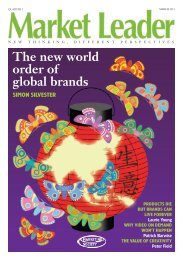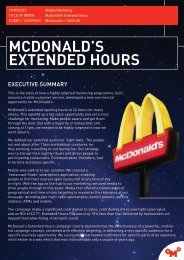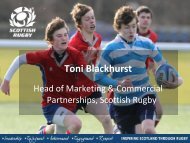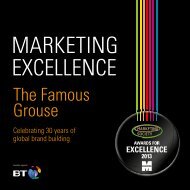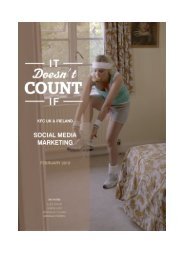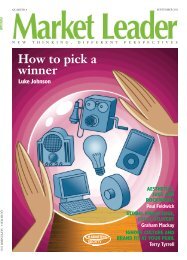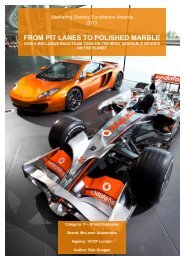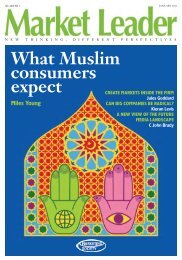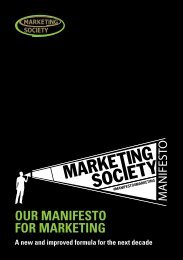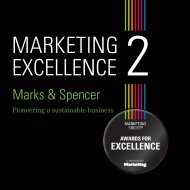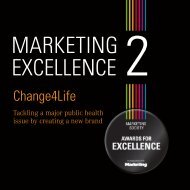marketing excellence 2 sky case study.pdf - The Marketing Society
marketing excellence 2 sky case study.pdf - The Marketing Society
marketing excellence 2 sky case study.pdf - The Marketing Society
- No tags were found...
You also want an ePaper? Increase the reach of your titles
YUMPU automatically turns print PDFs into web optimized ePapers that Google loves.
Foreword | <strong>Marketing</strong> Excellence 2 |ForewordBy Roisin Donnelly,President of <strong>The</strong> <strong>Marketing</strong> <strong>Society</strong>What is <strong>marketing</strong> <strong>excellence</strong>?Roisin DonnellyPresident of<strong>The</strong> <strong>Marketing</strong> <strong>Society</strong>Corporate <strong>Marketing</strong>Director and Head of<strong>Marketing</strong> at Procter &Gamble UK and Ireland<strong>Marketing</strong> <strong>excellence</strong> can drive breakthroughbusiness results for the short and longterm. <strong>Marketing</strong> <strong>excellence</strong> requires greatstrategic thinking, great creative thinking andperfect execution.But how do we assess <strong>marketing</strong> <strong>excellence</strong>?First we choose brilliant industry judges who areall experienced and successful practitioners of<strong>excellence</strong> and we ask them to pick out the <strong>case</strong>swhich they see as remarkable. We ask them tolook for two key qualities from our winners:creativity and effectiveness.But <strong>marketing</strong> continuously changes and evolves,as consumers become more sophisticated anddemanding and the media for communicatingwith them ever more diverse. So the standardsfor <strong>marketing</strong> <strong>excellence</strong> change and in turnbecome more demanding.We believe that <strong>The</strong> <strong>Marketing</strong> <strong>Society</strong> Awardsfor Excellence in association with <strong>Marketing</strong> set thestandard of <strong>marketing</strong> <strong>excellence</strong> in the UK. <strong>The</strong>yhave established this reputation over a period ofmore than 25 years, and they have always beenbased on the principle of searching out the bestexamples of different <strong>marketing</strong> techniques inaction, that show<strong>case</strong> great strategic thinking,great creativity and perfect execution.In order to be a winner of one of the <strong>Society</strong>’sAwards, marketers have to demonstrate that whatthey have done is outstanding in comparison with<strong>marketing</strong> in all industries not just their own particularsector.If a <strong>marketing</strong> story has been good enough toimpress our judges, then all marketers can learnfrom it – however senior they have become. <strong>The</strong>collection of <strong>case</strong> histories brought together inthis book is the best of the best from the past fouryears of our Awards, and I am confident that it trulydemonstrates <strong>marketing</strong> <strong>excellence</strong>. I have beentruly inspired by these <strong>case</strong> studies and I hope youwill be too.
1 | Customer Insight | Sky+ | Finding the right route to an elusive audienceSky+Finding the right routeto an elusive audienceSnapshotCustomer insight helped Sky engage successfully witha new and hard-to-reach audience for the Sky+ brand.Key insights• <strong>The</strong> compelling insight that Sky gained aboutits new target audience — that it resisted thehard sell — formed the basis of a demonstrablyeffective campaign.• Using celebrities who would resonate with thisaudience to enthuse in their own words about thebrand set the right tone.• Tying this all up into a multi-channel, integratedcampaign made the whole far more than the sumof its parts.This <strong>case</strong> <strong>study</strong> shows how Sky was able to appealto a new audience by understanding that sometimesit is more powerful to get your customers to tell yourstory. Face-to-face sessions with customers revealedhow much more compelling advocacy can be over aconventional brand selling approach. <strong>The</strong> companyreplicated this powerful tool by using celebritytestimonials to accelerate advocacy and get peopletalking about Sky+ through a multi-channel, integratedcampaign.<strong>The</strong> campaign brought a new audience to thechannel and produced the strongest fourth quarternet additions in five years.SummarySky operates the most comprehensive multi-channeltelevision service in the UK and Ireland, offeringmovies, news, entertainment and sports channelsand interactive services on Sky digital to over 9.7million households. One of its major services is Sky+,a personal video recorder launched in 2001, whichallows up to 40 hours of TV to be recorded andwatched later.
Finding the right route to an elusive audience | Sky+ | Customer Insight | 2Coping with a changing marketAt the beginning of 2008, Sky had just under nine millioncustomers. With a public target of 10 millioncustomers by 2010, there was a lot to play for. Butwith the growth of the Freeview base to over 14million households, convincing people to pay for TVwas becoming increasingly challenging. (Launched inOctober 2002, the Freeview service provides free-toairdigital TV channels, radio stations and interactiveservices through an aerial. It is owned and run byits five shareholders — BBC, BSkyB, Channel 4, ITVand Arqiva.)In 2007, the value-driven sales message of ‘See,Speak, Surf’ promoting broadband and talk alongsideTV had successfully grown Sky’s market share. Butthe company could no longer rely on value alone toattract new customers. Appealing to a new, harderto-reachaudience was essential in order to achieveits targets.Research indicated that many Freeviewers did notthink that Sky was relevant to them. <strong>The</strong>y saw Skyas delivering ‘more TV’ rather than ‘better TV’.Moreover, they were already satisfied with theirfree digital channels.<strong>The</strong> demographic profile of available customerswas also changing. In particular, there was agroup of older 55+ Freeviewers. <strong>The</strong>y were harderto reach, with more barriers to advertising and tothe Sky brand. <strong>The</strong> company worked closely withDr Ken Dychtwald, an expert on ageing-relatedissues, to understand how to engage them. <strong>The</strong>yappreciated authenticity and ideas that reflectedtheir lives. <strong>The</strong>y rejected complex and metaphoricalcreative concepts, but were also patronised by adsthat they felt were too obviously targeted at theirgeneration. More than anything, they valued thingsthat were useful rather than wasteful.So Sky needed to find an approach that would makethe service relevant to their lives. A quantitative<strong>study</strong> was designed to understand the key barriersand conversion triggers that could move Freeviewersto consider the service. Sky+ was found to be one ofthe most efficient triggers. It would revolutionise howthey watched TV and help them feel more in controlof their viewing.Rethinking the <strong>marketing</strong> of Sky and Sky+Since its launch in 2001, Sky+, a personal videorecorder which allows up to 40 hours of TV to bewatched and recorded later, had been an incrediblysuccessful product for the company. In March 2008,just over a third of Sky households had Sky+.However, if portraying the benefits of Sky+ to its owncustomers was difficult, attracting new customers toSky through Sky+ would be even harder. Sky hadalways struggled to unlock its attractions in alarge-scale <strong>marketing</strong> campaign. <strong>The</strong> company knewfrom the enthusiasm of existing Sky+ customers thatit was indeed a life-changing product, but had neverbeen able to convey its magic to potential customers.<strong>The</strong>re was thus a mismatch between high levels ofcustomer satisfaction and unfulfilled sales potential.<strong>The</strong> way it wasIn the past, Sky had adopted two different<strong>marketing</strong> strategies.• <strong>The</strong> technological benefits. In 2006, as part of the‘What do you want to watch?’ campaign, clips ofcontent were paused, rewound and fast-forwardedto illustrate the benefits of Sky+. But this did littleto demonstrate the true capabilities of the service.It succeeded in communicating the functionalbenefits, but failed to highlight lifestyle benefits.• <strong>The</strong> social benefits. In 2007, the ‘Brain’ campaignwas designed to emphasise the emotional benefits
3 | Customer Insight | Sky+ | Finding the right route to an elusive audienceof control by showing how you can carry on your lifewithout missing your favourite programme.But this over-stated the importance of televisionin people’s lives: people didn’t want to admit thatTV was a greater priority than their social life.<strong>The</strong> company thus needed to find a way that wouldbalance the lifestyle benefits with the technologicalbenefits, be simple and motivating and whichwould create desire for the product, while alsoshowing how easy it was to use, particularly foran older audience.Digging deeper to find the right answer<strong>The</strong>re was a paradox at the heart of the problem.Anyone who had Sky+ would tell you how it had revolutionisedtheir life. But anyone who didn’thave Sky+ couldn’t see what all the fuss wasabout. <strong>The</strong>refore, to get under the skin of whatit was the owners loved about it, the companyasked them (Figure 1).<strong>The</strong>ir stories were a combination of social andtechnological benefits, but it was the personaltouches, enthusiasm and language that broughtthe benefits of Sky+ to life. <strong>The</strong> real breakthroughcame, however, when the company carried out some‘customer closeness research’. Sky regularly heldthese sessions to give executives the opportunityto talk face-to-face with customers and prospects.<strong>The</strong> research session was split into two halves.In the first half, Sky executives had the opportunityto explain the benefits of Sky to 55+ Freeviewprospects. Nevertheless, the Freeviewers remainedunmoved. In the second half, Sky customers wereasked to explain the benefits of Sky and Sky+ tothe Freeviewers. <strong>The</strong> mood of the room changedinstantly. <strong>The</strong> customers were able to give theFreeviewers real examples of how they usedSky+ and how it had improved their lives. By theend of the session, the Freeviewers wanted toknow where they could sign up.<strong>The</strong> power of advocacy<strong>The</strong> solution became clear to Sky: tell, not sell.<strong>The</strong> most powerful approach would be to getcustomers to be advocates.In the past, the company had encouragedcustomers to tell their friends on a smaller scalewith a ‘member-get-member’ scheme which hadproved very successful. In fact, before the campaign,20% of Sky+ boxes had been sold by existingcustomers. This effort needed to be given a boostby broadcasting it. However, because a campaignusing customers would not give the impact needed,the company decided to use celebrities to getpeople talking.Sky had a major advantage: many celebrities hadSky+ because of their busy lives, and spontaneouslypraised the service in public. Celebrities were alsoa much easier way to have a conversation with 55+Freeviewers. <strong>The</strong>y were cynical about advertisingmessages, so the company sought to create acampaign that would feel more like a relaxedconversation with someone they respected. Thismixed the impact of celebrity with the credibilityof advocacy.<strong>The</strong> celebrities selected were genuine Sky+ customers.<strong>The</strong>y were real advocates and enjoyedthe status of ‘national treasures’ as some of thecountry’s best-loved celebrities and could reflect Sky’sBritish heritage. Those chosen were straightforward,down-to-earth and whose point of view would berespected. In addition, the company chose celebrities
Finding the right route to an elusive audience | Sky+ | Customer Insight | 4Series link is amazing.It makes hangoversfun. I cancrawl to the sofawith my duvet andwatch AmericanIdol, Dragon’s Den,Ramsay’s KitchenNightmares USAor something likethat...My mum phones every Sundayevening. I like to watch a filmon Sunday evening. My mumcan sense exactly when I startwatching the film and calls me.I can pause TV now. I win.It has meant I get to see my oldestson more — now he tapes hisfavorite programme (Rugby Club)and spends more time at home onSunday afternoon watching it withme when he’s back from (boarding)school...It means I get to replay the goalsfrom the Arsenal game as soonas I get home from watching thematch live at the ground.It means I can watch the right programmeto suit my mood — e.g.comfort food TV when late homeafter work, a good drama whenI’m home early enough to watchsomething with Liz, two back-toback episodes of Uni Challenge ifwe want a quiz night...My sister uses hers torewind crime dramasto check if the clueswere there the firsttime. Sad I know, butshe’s a solicitor.I no longer have to watch ads. That buys me a good 15 mins ineach hour of programming. I’m a typical 16 hours of telly a weekguy (an hour or two each night and maybe more at the weekend)— that means I recoup four hours of my life each week throughSky+. Since I got it a year ago, that works out at 208 hours or almost8.66 days. So Sky+ has effectively given me an extra week ofholiday — what single thing bar teleportation can give me so muchadditional free time?Figure 1. How does Sky+ change peoples lives?Source: WCRS Qualitative
5 | Customer Insight | Sky+ | Finding the right route to an elusive audiencewho hadn’t done many other ads to emphasise theirgenuine enthusiasm for the service. <strong>The</strong>y were thekind of people the target audience would love tohave a chat with: Sir Michael Parkinson, Ross Kemp,Mariella Frostrup, Felicity Kendall and Kelly Brook.message were designed to overcome this barrier(Figure 3).<strong>The</strong>re was also an analysis carried out of testimonialcampaigns to establish the rules of how best todeliver the campaign (Figure 2).GOODReal customerand advocateNOTBADCustomerspokespersonNatural conversation(from the heart) NOT Forced scriptHuman benefit ofthe product NOT Product attributesMy story NOT Product sellEntertaining NOT InformingFigure 2. What makes a good testimonial?<strong>The</strong> creative and tonal approach chosen was deliberately‘un-Sky’. In the past, Sky communications hadbeen quite information-rich and slick. <strong>The</strong> companypurposely adopted a quieter and more pragmatic style.<strong>The</strong> intention was not to ‘sell’ the product, but to havecelebrities genuinely enthuse about it.To ensure authenticity, the celebrity interviews werecompletely unscripted. <strong>The</strong> company knew neitherwhat they would say, or how they would say it. Whilethis was a leap of faith for the company, it realisedthat their words would be more powerful than anywords written for them.<strong>The</strong> print ads were also designed to be simple andclean. <strong>The</strong> company realised that many people wereworried that Sky+ would be too technological andcomplex to use, so the body language and campaignFigure 3. <strong>The</strong> Sky+ campaignA consistent and integrated approach<strong>The</strong> media strategy was to target two key groups:1. Three million Sky+ customers: the companyrealised that the best form of advertising would beto stimulate existing customers to evangelise abouttheir love of the product.
Finding the right route to an elusive audience | Sky+ | Customer Insight | 62. Freeviewers: particularly focusing on the 55+age group.<strong>The</strong> campaign was integrated through-the-line andused TV, outdoor, national radio promotion (whereSky+ customers were encouraged to call in andspeak to radio presenters about the benefits ofSky+), direct door drops, press, media inserts,online activity, public relations, point-of-sale andinternal communications.Sky+ campaign created significant positiveBuzz Sky+ around campaign the created Sky Brand significant positiveBuzz around the Sky Brand8866442200-2-2-4-4-6-62-07-072-07-07Brand TVRsFigure Brand 4. Sky+ TVRs campaign created Buzzsignificant positive buzz around theSky brand. Source: YouGov/Brand Indexu z z T otal S coree : Y ou G o v B ran d Ind exu z z T otal S core27-08-0727-08-07e : Y ou G o v B ran d Ind exBuzz14-01-0814-01-0824-03-0824-03-0805-05-0805-05-0816-06-0816-06-08350350300300250250200200150150100100505000Achieving record results<strong>The</strong> campaign transformed the fortunes of the brandin a number of critical ways.1. <strong>The</strong> campaign helped Sky to have its strongestfinal quarter in five years. Running for the majorityof the fourth quarter in 2006, it was instrumentalin helping Sky produce its strongest fourth-quarternet additions in five years. This was attributed tothe success of the Sky+ advocacy campaign, whichcontributed more than 321,000 quarterly net Sky+additions — only the third time ever that Sky hadachieved such strong results.2. <strong>The</strong> campaign changed perceptions of the Skybrand. <strong>The</strong> fresh, tonal approach of the campaignhelped people to see Sky in a new way. Followingthe campaign the company saw statisticallysignificant increases in the following measures:• “Sky makes life easier for its customers”.• “Sky has the best technology”.In qualitative groups following the campaign,people picked up on that change of tone: “It’s notat all what you’d expect from Sky. It’s much quieter,but it’s much more likely to get my attention”.3. <strong>The</strong> campaign created unprecedented ‘buzz’for Sky. An independent YouGov survey showeda significant increase in buzz for the brandduring the campaign period (Figure 4), suggestingthat the campaign was successful in creatingaccelerated advocacy. It also achieved high levelof awareness.4. <strong>The</strong> ‘advocacy’ approach attracted a new audienceto Sky. Crucially, a record 55% of Sky+ additionswere new to Sky (the highest number of newadditions ever in a quarter, proving that the fresh
SponsorsAviva - 300 Years of InsightWe’re the world’s sixth-largest insurance group and the biggest in theUK, with 46,000 employees that everyday serve 53 million customersworldwide.We are committed to delivering one distinctive experience for ourcustomers. Wherever they are, we want them each to feel that “noone recognises me like Aviva”. Our global consumer research revealsthat most of our competitors are particularly bad at recognisingpeople’s individual significance. This research also tells us that smallhuman touches can make a huge difference to a customer’s experience.Our aim is to make recognition the familiar quality thatdistinguishes Aviva from our competitors - just as Apple meansuser-friendliness and FedEx means reliability.“We know insurance isn’t just about policies’ and pensions; it’s aboutpeople. That’s why we’re making our customers the big picture, puttinga spotlight on them and our people. Putting customers at the heart ofeverything not only makes sense for them, it makes good commercialsense too.” (Amanda Mackenzie, Aviva’s chief <strong>marketing</strong> and communicationsofficer)We are working hard every day to build the company around what ourcustomers want from us. That’s why Aviva now ranks among the UK’stop ten most valuable brands, according to the 2010 Brand FinanceGlobal 500 survey and that success is something we are looking toreplicate across the world.BT operates in over 170 countries and is one of the world’s leadingcommunications services companies. BT is a major supplier of networkedIT services to government departments and multinationalcompanies. It’s the UK’s largest communications service provider toconsumer and business markets and is made up primarily of fourcustomer-facing lines of business: BT Retail, BT Global Services,Openreach, and BT Wholesale.BT operates in a thriving, multi-trillion pound industry that spans thewhole world. In recent years the global communications market hasbeen focused on convergence, whereby the boundaries between telcos,IT companies, software businesses, hardware manufacturers andbroadcasters have become intertwined to create a new communicationsindustry.BT has evolved from being a supplier of telephony services to become aleading provider of innovative communications products, services,solutions and entertainment products. BT’s business customersrange from multinational, multi-site corporations to SMEs andstart-ups.More than 80 per cent of the FTSE 100 and 40 per cent of Fortune500 companies rely on BT for networking, applications and systemintegration. <strong>The</strong> National Health Service, Procter & Gamble,PepsiCo, BMW, Emirates, Fiat, Microsoft, Philips, and Unilever arejust some of the organisations working with BT.BT has been a driving force behind the success of ‘BroadbandBritain’. Thanks to the company’s investment, nearly every home inBritain now has access to broadband and in September 2009, BTannounced plans to more than double the availability of its fastestfibre broadband service.
MARKETING EXCELLENCE 2“A treasure trove of examples covering the whole waterfront, from launching new brands to revitalising, sustainingand extending established ones, and from insights to advertising and sustainability. Whatever your business, it shouldmake you proud to be a marketer, shake up your thinking and inspire you to go the extra mile.”Professor Patrick Barwise, London Business School, Chairman of Which?“This exciting book demonstrates how great <strong>marketing</strong> can solve the most difficult problems, through analysis,teamwork and creativity.It contains 34 fascinating <strong>case</strong> studies, selected from hundreds of high quality entries to <strong>The</strong> <strong>Marketing</strong> <strong>Society</strong>Awards for Excellence. Those involved had the determination to win, and the courage to think differently.An inspiring read.”Professor Hugh Davidson, Co-Founder, Oxford Strategic <strong>Marketing</strong>“This is the textbook, the toolkit and the manual for <strong>marketing</strong> <strong>excellence</strong>.”Cilla Snowball, Chairman, AMV BBDO“<strong>The</strong>se <strong>case</strong>s are a great source to stimulate your thinking. Some will stimulate new thoughts, some will unlock ideasfrom the back of your memory. All of them however are great fuel for growth.”Keith Weed, Chief <strong>Marketing</strong> and Communication Officer, UnileverFeaturing 34 award-winning <strong>case</strong> studies from some of the world’s leading brands:Sky+ BT Business NHS Blood and Transplant Magners Change4Life alli O2 Waitrose KFC McDonald’s HovisBritish Gas Audi Marks & Spencer Virgin Atlantic Dulux Sainsbury’s Pedigree Thinkbox Harlequins More Th>nUPS Walkers Aviva ebookers Shell ICI Paints Channel 4 British Heart Foundation Keep Britain Tidy Ariel© Copyright <strong>The</strong> <strong>Marketing</strong> <strong>Society</strong> 2010. All rights reserved.This PDF edition is for the personal use of the purchaser who may print from it a single copy. It may not be reproduced, posted on intranets,extranets or the internet, e-mailed, archived or shared electronically either within the purchaser’s organisation or externally withoutexpress written permission from <strong>The</strong> <strong>Marketing</strong> <strong>Society</strong>. To share this PDF with colleagues at the same site or across multiple sites withinan organisation by email or via an electronic network please contact <strong>The</strong> <strong>Marketing</strong> <strong>Society</strong> to purchase an appropriate licence.in association withsponsored byTo download further <strong>case</strong> studiesor purchase the book, <strong>Marketing</strong>Excellence 2, please visitwww.<strong>marketing</strong><strong>excellence</strong>.org.uk orPhone 020 8973 1700



